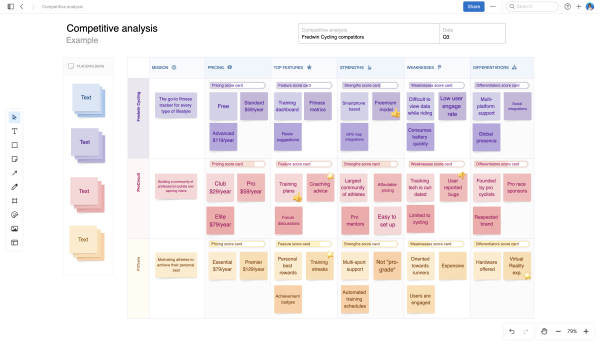Product feedback: How product teams gather feedback
Gathering customer feedback is a pathway to product innovation. You can discover how people feel about a potential feature. You can validate assumptions about user behavior and market trends. You can even spot unmet needs — finding use cases you had not previously considered. The insights you gain from these customer discussions are invaluable to building a successful product.
Encouraging your customers to voice their opinions can also help foster a more positive relationship with them. When customers know that you care about what they have to say, they are more likely to feel invested in your offering — and willing to help you improve it. This is how you build a community of folks who are loyal to your company over the long term.
Product managers gather customer feedback using a variety of methods — this guide offers an overview of several. One of the most popular and reliable approaches is to conduct customer interviews. We offer a customer interview note template in Aha! software that is useful when you are talking to customers, recording insights, and identifying common feedback themes.
Feel free to jump ahead to any guide section:
What should you consider before collecting product feedback?
What should you do with your findings from your customer feedback?
Collect customer interviews using the template below — with a free trial.
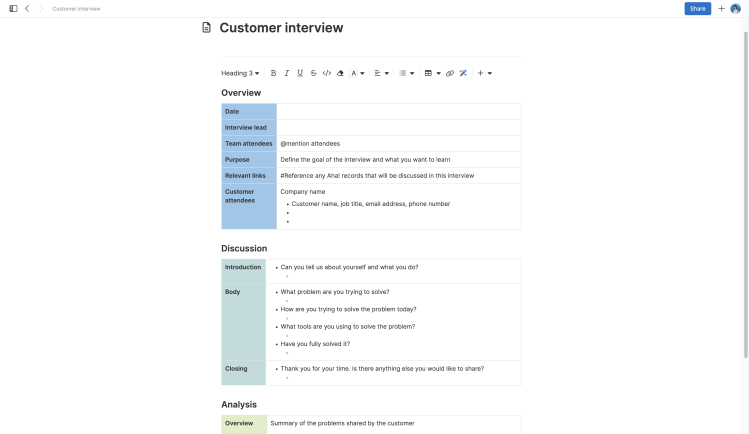
What is product feedback?
Customer feedback is about interacting with your target audience to get their opinions about a product or service. This is essential for truly understanding their behavior and needs. For product managers, it is especially important — you have to grasp your users' challenges before you can deliver a valuable solution.
So how do you collect actionable feedback that leads to product innovation? It starts with listening. Many teams engage with customers via different methods (e.g., interviews, surveys, focus groups) to discuss their experience with the product. Some companies also use an online ideas portal to empower their users to freely share their suggestions for improvement. This gives you added clarity about what people are requesting and how you can deliver it.
But asking questions and listening to answers is just the beginning. You need to dig deeper. The best product managers go beyond a customer's initial comment or request to uncover exactly what they need. Doing this requires empathy — the ability to experience another person's challenges as your own. When you can pair your research with this core skill, it is easier to create meaningful solutions.
Related: 7 customer research templates for product managers
What should you consider before collecting product feedback?
Before you start collecting feedback, define a clear objective. Outlining what you want to learn helps to focus your research — so you can determine which potential or existing customers you want to engage with. This is especially helpful if your product or service appeals to a diverse group of people. Varied customer segments can have vastly different product use cases. So it is important to be clear about who you want to talk to and what you are hoping to discover.
Once you set your goals and decide which groups you will speak to, it is time to choose your methods for gathering feedback.
Related: Introduction to idea management
What are some methods for gathering product feedback?
You can approach gathering feedback in a number of ways — from quick, single-question polls to in-depth focus group sessions. The methods you choose will depend on your company, product type, and product development lifecycle phase. Keep in mind that a combination of methods can help you gain more well-rounded insights.
Regardless of which methods you use, the most important thing is to keep the feedback flowing. You always need an influx of ideas to continue delivering value to customers. That means collecting ideas and feedback should be an ongoing process, both for brand new products and existing ones.
Here are some of the ways that product managers gather customer feedback — grouped into qualitative and quantitative categories, plus a few that are both:
Qualitative methods
Customer interviews | Customer interviews give individuals the opportunity to tell you about how and why they use your product. You can gain important insights about how your product is working (or not) and validate or disprove your assumptions about customer behavior. Ask open-ended questions (that start with "who," "what," "when," "where," "why," or "how") to encourage people to give thoughtful and detailed responses. |
Focus groups | Focus groups consist of interviews in which a small group of prospects or customers is asked about their perceptions, opinions, or attitudes towards your product. Groups should be demographically diverse to ensure unbiased data. The goal of the discussion is to determine how a larger population will react to a new or updated product. During the session, questions are asked in an interactive setting where customers are free to talk openly with other participants. Product managers or other researchers take notes or record the session for later analysis. |
Customer advisory boards | Customer advisory boards are groups of existing customers that meet periodically to share their observations and insights with a company. Typically these customers are C-level executives at other organizations who offer strategic guidance on the product, market, and broader industry trends. The ideas that come out of these conversations can inform the product roadmap and help the team prioritize what to build next. |
Virtual research sessions | Virtual research sessions are online, chat-based conversations between product teams and customers that typically occur in real time. They allow you to develop rapport with your users and notice patterns in what people request. At Aha! we hold empathy sessions — designed to help you capture insights about what people truly think and feel about different topics. |
In-app community feedback | In-app community feedback gives people the ability to engage in an online chat with a member of your team. You receive direct and immediate feedback from customers while they are actually using your product. You can respond to them in real time, when their question or need is most urgent. This helps you discover what users think and how they are experiencing different parts of your application. |
User forums | User forums are online discussion sites where members can post messages about your product or service. User forums can reduce support costs because customers will often answer each other’s questions. People may use forums to make feature requests, share ideas for how to improve your product, or talk about how they have used your product in a unique or unintended way. Ultimately, by actively reading and engaging with these discussions, you can better understand who your users are and the problems they are trying to solve. |
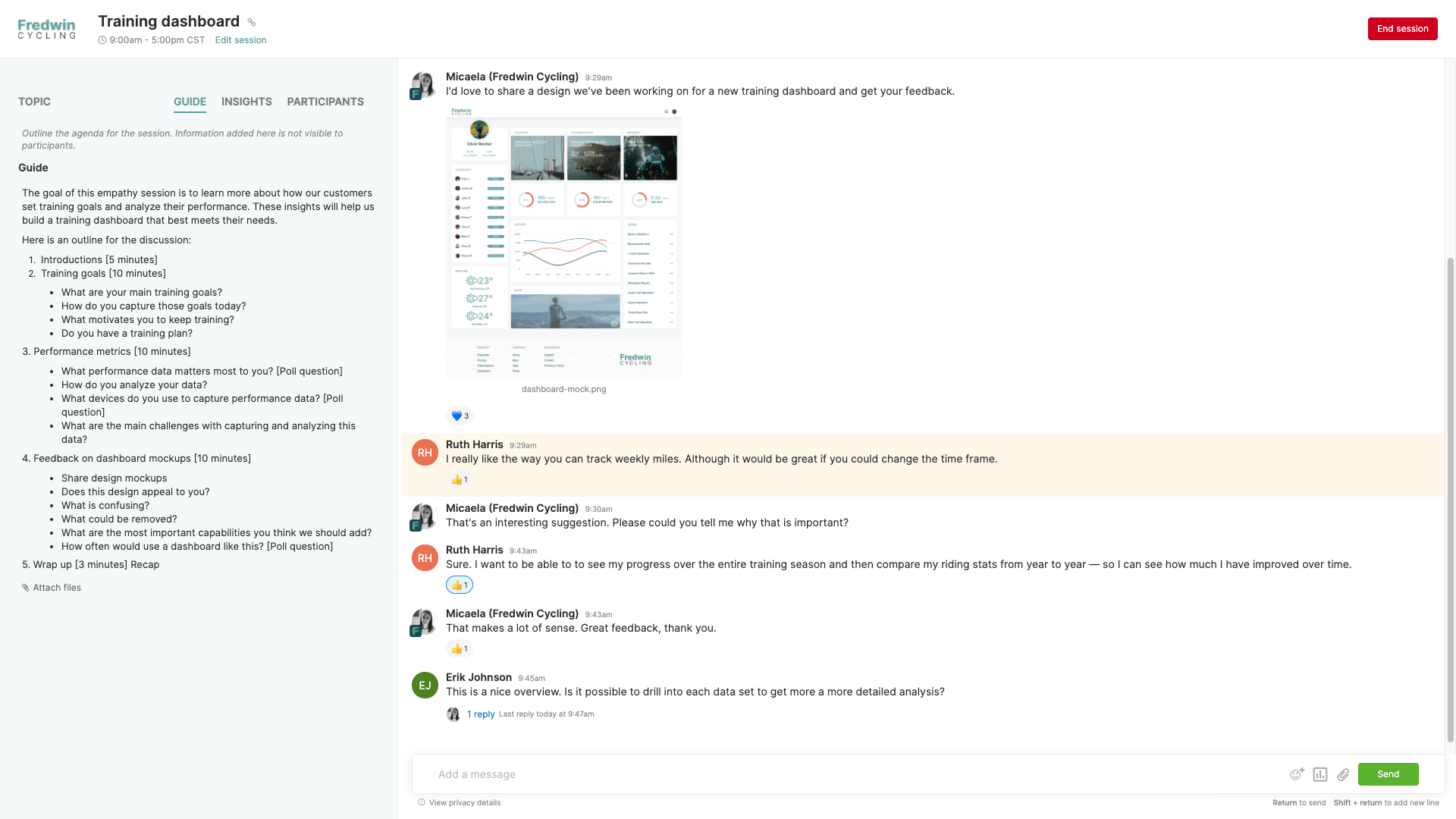
Engaging with customers in an Aha! Ideas empathy session.
Quantitative methods
Polls | Polls enable product managers to obtain quantitative feedback about customer sentiment. They typically consist of a specific question followed by a few multiple choice answers. Poll data can validate an assumption or give a glimpse into how different groups of people feel about your product. |
A/B testing | A/B testing is used to identify changes that increase an outcome of interest. For example, you might test two web pages that are identical except for one variable such as a headline, image, or color scheme. The results of the test give you insights into which messages and designs people prefer — so you can make better decisions about what will appeal to customers and iterate quickly. You can use A/B testing to gain immediate insights during beta testing or even after a launch. |
Analytics | Product analytics tracks user behavior. This data helps product managers understand the path each customer takes and how they are using the product. Typically, this lets you look across aggregate data sets or break information down to individual users. |
Both qualitative and quantitative methods
Ideas portal | An ideas portal is a web-based interface that enables your customers to submit their suggestions for your product. A portal provides a continuous feedback loop — customers can describe their current pain points and share ideas at any time. You can then communicate directly with people who have submitted feedback. Capturing ideas in one place lets you crowdsource feedback, identify trends, and analyze the business value of each idea. Some idea management software also includes voting capabilities, so participants can view and vote on ideas submitted by others. This gives everyone a voice and provides clarity on what matters most to your users. |
Customer-facing teams | While customer support teams interact closely with users to answer their questions and troubleshoot issues, sales teams speak with current and potential customers to learn more about their needs. Because they talk to prospects and customers on a daily basis, both teams have valuable insights into the user experience. Regular cross-functional communication is essential for maximizing these insights. Product managers can tap into this knowledge by shadowing help calls, answering support tickets, or attending discovery calls. In turn, customer support and sales teams can participate in the ideation process with proxy voting. This allows them to vote for an idea on behalf of customers — so they can represent and share the feedback they are receiving from users. |
Usability testing | Usability testing measures a product’s capacity to meet its intended purpose. It usually involves creating a realistic situation where customers perform a list of tasks using your product. Product managers and other observers watch and take notes as participants complete the assigned tasks. The purpose of usability testing is to observe how customers actually interact with your product. This helps you identify problem areas within your offering, spot design features that need to be changed, and capture metrics such as task completion rates. |
Survey | Surveys allow product managers to ask customers questions in a variety of quantitative (e.g., sliding scale) and qualitative (e.g., open-ended response) formats. They are a low-cost, scalable way to capture feedback on a wide variety of topics from a large group. Survey data can help you turn your assumptions into facts and support or disprove hypotheses you have about customers and the product. |
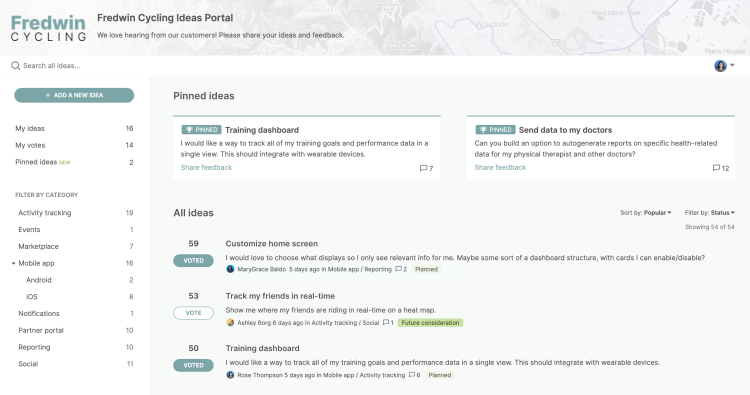
Customer ideas and votes captured in an Aha! Ideas portal.
What should you do with the findings from your customer feedback?
After your research is complete, it is time to analyze your findings and take action. But it can be easy to get lost in all the data, especially if you are using multiple methods to gather feedback. So how do you decide which ideas to pursue and when?
Start with strategy. You need to score the business value of each idea against your overall objectives. Prioritize the requests that support the larger company and product goals. You can then promote the best ones to your product roadmap. Be sure to share what you have learned with the rest of the team. This will align everyone around the "why" behind the work you are planning to do.
A simple framework can help you get started. For example, a problem statement template lets you examine customer challenges and potential solutions from the user's point of view. It is a great way to organize your high-level findings from your customer feedback and share them with your team before committing to real product work.
Use this problem statement template in Aha! software — with a free trial.
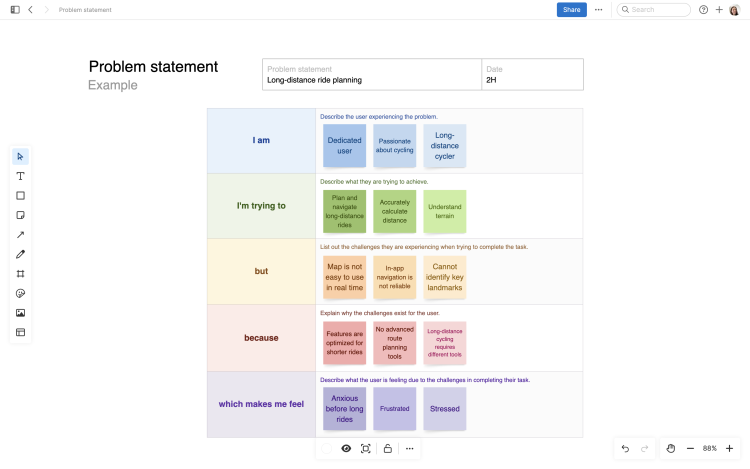
Customer feedback is a valuable tool for learning what people think and feel about your product. But even with the best research in hand, the feedback you collect only reflects one moment in time. Customer needs evolve and understanding what people want is an ongoing process.
Increasing your understanding of what people really need is key to delivering a product or service that they love. When you allow customers to become active participants in the product development process, innovation can truly thrive.
